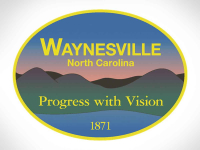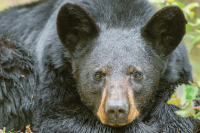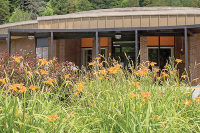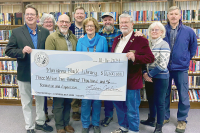Rekindling memories of High Rocks
This is about a place, High Rocks, a lookout situated at just over 5,000 feet on Welch Ridge in the national park. Welch Ridge is the massive divide between Forney and Hazel creeks on the North Carolina side of the park. On the exposed outcrop at High Rocks, a fire tower and ranger’s cabin were constructed during the 1930s.
This is also about the relationship with that place my wife, Elizabeth, and I have maintained for three decades and counting. Our part of the story now exists on various levels, but the primary venture involving High Rocks took place in early August 1982. It had been preceded by visits dating back into the 1970s. In addition to the journal notes, sketches, Polaroid snapshots, etc., made in 1982, a narrative description of mine titled “High Rocks” was published in the “Fall-Winter 1982” issue of The Wayah Review; and a column was published in Smoky Mountain News some time ago that re-created a portion of the journal notes verbatim.
Not long ago, I chanced upon my missing issue of The Wayah Review.
What follows, after some additional window dressing, is a fragment from that narrative somewhat altered in style and incorporating journal entries. What I write in July 2010 is neither better nor worse than what I wrote in September 1982. Writing it again is my way of reviving memory.
High Rocks is one of those magical places. Like an entranceway to Shangri-La, stone steps constructed by CCC workers lead up to the tower for hundred of yards under a dense tangle of rhododendron. The views from the tower out over the southwestern tip of North Carolina were stupendous. I use the past tense because the fire tower is no longer there. The park service removed it with a helicopter in the late 1980s. (Insofar as I am aware, the ranger’s cabin remains, but I haven’t been back there since August 1982.)
As trips go, it wasn’t very long — maybe 25 miles roundtrip from Lower Lands Creek, where we live on property just west of Bryson City to High Rocks and back. In retrospect, our route to High Rocks might seem peculiar. We chose to portage our canoe down Lands Creek to Lake Fontana, paddle to the mouth of Goldmine Creek (camp for a night), paddle the next morning to the mouth of Forney Creek, hike up Forney Creek trail, follow the aptly-named Jumpup Ridge trail to the crest of Welch Ridge, and push on up from there to High Rocks, where we had obtained a permit from a backcountry ranger to use the cabin.
Related Items
Lake Fontana … three men and a woman drink beer and nod with indifference as we float past … green heron squawks from a tangle … Goldmine Creek camp … rose-colored mallows the size of dinner plates growing in shallows … up in light drizzle utensils clinking coffee oatmeal … canoe flows over lake water … mouth of Forney rock-ribbed darker water… long-bearded middle-aged fellow red-faced yelling in front of a yellow tent wearing a yellow T bearing the succinct message in orange script: ‘FLORIDA!’ … keep on moving … cache canoe … Jumpup Trail … steep switchbacks gray rainwater running in rivulets … pause every 20 minutes or so w/ no need to talk . . . push up to grassy saddle atop Welch Ridge w/ E effortlessly beside me … signpost: “High Rocks 1 mi” pointing south … and the rain stops.
Trail junctions have a special quality. I don’t mean the bit about paths untaken. I mean the union a junction represents. Most manmade connections are awkward but you will never come upon a confluence of pathways that is not as it should be.
We hide our packs off-trail. It’s sweet to get out from under them. For a while, we float several inches off the ground. Water up at High Rocks will be iffy. So we go north on the main trail … past white wood aster, starry campion, horse balm, and blue panicles of harebell … over Bearwallow Bald and down to a glade below Hawk Knob to fill our water bags.
Unseen and yet nearby, a bird sounds
three clear notes as the sun flashes
filling the moist glade with light.
A maze of scarlet bee balm flames
to life along the edge of the trail
and farther down there is the
glow of a single pendant lily.
The bird sings again a song
meaningless and profound
that somehow secures
this moment in
my memory.
Steep trail up from main ridge to High Rocks . . . stone steps carved from granite splotched with patches of lichen … rhododendron boughs arched overhead … glistening black muck underfoot … lush moss is emerald green in this dim underworld … step after step & finally the top.
Rock and tower and cabin.
There is an emptiness that we fill.
From the tower after the swirling mists
had been blown away were views that
took our breath away: all across the Smokies
from Deeplow Gap to Shuckstack and
southward over the Cowees and Nantahalas
into Georgia ... blue ridge after blue ridge
in every direction.
George Ellison wrote the biographical introductions for the reissues of two Appalachian classics: Horace Kephart’s Our Southern Highlanders and James Mooney’s History, Myths, and Sacred Formulas of the Cherokees. In June 2005, a selection of his Back Then columns was published by The History Press in Charleston as Mountain Passages: Natural and Cultural History of Western North Carolina and the Great Smoky Mountains. Readers can contact him at P.O. Box 1262, Bryson City, N.C., 28713, or at This email address is being protected from spambots. You need JavaScript enabled to view it..









